











|
Asteroid 433
On February 14, 2000 at 10:33 AM EST the NEAR spacecraft was successfully inserted into orbit around 433 Eros, becoming the first artificial satellite of an asteroid. Just over an hour later, NEAR pointed its camera at the asteroid and took the above picture from a range of 210 miles (330 km) above the surface.
NEAR was launched on February 17, 1996 as the first of NASA's Discovery missions to rendezvous with asteroid 433 Eros. During the journey to Eros, NEAR flew within 1212 kilometers (750 miles) of asteroid Mathilde on June 27, 1997. NEAR was to continue onto Eros and obtain orbit in December of 1998; however, due to a computer glitch the rendezvous burn of NEAR's bipropellant engine was aborted. This failure caused NEAR to fly past the asteroid on December 23, 1998. Mission operators quickly reprogrammed the spacecraft to obtain scientific flyby information and to put the spacecraft into an orbit that would eventually reach Eros in February 2000.
Eros is approximately 33x13x13 kilometers (20x8x8 miles) in size
and resembles a "fat banana." It is the second largest near-Earth
asteroid and spins on its axis
once every 5 hours, 16 minutes. Eros exhibits a heavily
cratered surface with one side dominated by a huge,
scallop-rimmed gouge, and the opposite side by a
conspicuous sharp, raised rimmed crater.
| Views of Eros |
|---|
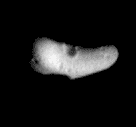 |
Features as small as a 1100 feet (330 meters) across can be
seen. The most prominent, sharp-rimmed impact crater is on
the opposite side of Eros form a huge, hollowed-out gouge,
which may also have been caused by an impact. Between these
features, and towards the ends of the "fat banana" shape of
Eros, the asteroid's surface is covered with smaller
craters.
(Courtesy NASA/JHU-APL)
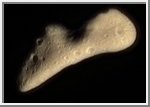 Eros in Color
Eros in Color
This color image of Eros was acquired at a range of
1100 miles (1800 kilometers). It is part of the final
approach imaging sequence prior to orbit insertion and is
intended to map the color properties of Eros across all of
the illuminated surface. The image shows approximately the
color that Eros would appear to the unaided human eye. Its
subtle butterscotch hue is typical of a wide variety of
minerals thought to be the major components of asteroids
like Eros.
(Courtesy of NASA/JHU-APL)
 Eros, in Stereo
Eros, in Stereo
Stereo imaging will be an important tool on NEAR for
geologic analysis of Eros, because it provides
three-dimensional information on the asteroid's landforms
and structures. This anaglyph can be viewed using red-blue
glasses to show Eros in stereo. It was constructed from
images taken on February 14 and 15 that showed the same
part of Eros from two slightly different viewing
perspectives. The smallest feature visible is 100 feet (30
meters) across.
(Courtesy of NASA/JHU-APL)
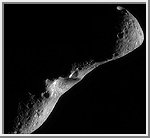 Eros Image Mosaic, Looking North
Eros Image Mosaic, Looking North
This image mosaic of Eros was taken by the NEAR spacecraft
on February 18, 2000 from a range of 224 miles (361
kilometers). The smallest detail visible on the surface is
about 115 feet (35 meters) across. At the time the
spacecraft was over the shadowed southern hemisphere,
looking north at a crescent Eros.
(Courtesy of NASA/JHU-APL)
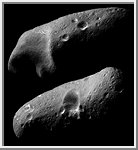 Eros's Eastern and Western Hemispheres
Eros's Eastern and Western Hemispheres
On February 23, 2000, the NEAR spacecraft obtained a sequence of image
mosaics showing Eros' surface as the asteroid rotated under the spacecraft.
At that time the range to the surface was approximately 355 kilometers
(220 miles). These two mosaics, part of that sequence, show the stark
beauty of the two opposite hemispheres. The smallest detail visible is
35 meters (120 feet) across. The top mosaic shows wavy brightness banding
exposed in the interior walls of the saddle. In the bottom mosaic, similar
banding is visible in one of the craters near the limb at left. To the
right, the angle of the illumination accentuates the quasi-linear troughs
near the terminator.
(Courtesy of NASA/JHU-APL)
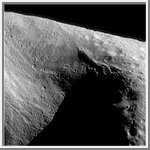 Interesting Structural Features on Eros
Interesting Structural Features on Eros
This image of the interior of Eros' saddle area, taken at a range
of 204 km (127 miles), displays a paucity of craters compared to
the surface on the right hand side of the image. The saddle displays
many interesting structural features. Visible on the left wall are a
series of closely spaced grooves that follow the terrain downslope.
Opposite, on the upper right wall, trending towards the back of the
saddle is a prominent ridge. Boulders are visible throughout this image.
Features as small as 20 meters (65 feet) are discernable in this image.
(Courtesy of NASA/JHU-APL)
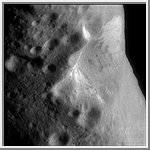 Oblique View of Eros' Crater
Oblique View of Eros' Crater
This image, showing an oblique view of Eros' large central crater,
was taken at a resolution of about 20 meters (65 feet) per pixel.
The brightness or albedo patterns on the walls of this crater are
clearly visible, with the brighter materials near the tops of the
walls and darker materials on the lower walls. Boulders are seen
inside this crater and the smaller nearby craters. The higher
density of craters to the left of the large crater implies that
this region is older than the smoother area seen associated with the
saddle region on the opposite side of the asteroid.
(Courtesy of NASA/JHU-APL)
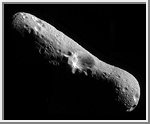 NEAR's First Whole-Eros Mosaic from Orbit
NEAR's First Whole-Eros Mosaic from Orbit
This picture of Eros, the first of an asteroid taken from
an orbiting spacecraft, is a mosaic of four images obtained
by NEAR on February 14, 2000, immediately after the
spacecraft's insertion into orbit. We are looking down over
the north pole of Eros at one of the largest craters on the
surface, which measures 4 miles (6 kilometers) across.
Inside the crater walls are subtle variations in brightness
that hint at some layering of the rock in which the crater
formed. Narrow grooves that run parallel to the long axis
of Eros cut through the southeastern part of the crater
rim. A house-sized boulder is present near the floor of the
crater; it appears to have rolled down the bowl-shaped
crater wall. A large number of boulders is also present on
other parts of the asteroid's surface. The surface of the
asteroid is heavily cratered, indicating that Eros is
relatively old.
(Courtesy of NASA/JHU-APL)
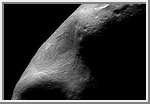 Inside Eros' Giant Gouge
Inside Eros' Giant Gouge
This picture was taken from NEAR on February 15, 2000,
while the spacecraft was passing directly over the large
gouge that creates Eros's characteristic peanut shape. It
is a mosaic of individual images showing features as small
as 120 feet (35 meters) across. Although most of the
asteroid is in shadow, we are able to see inside the gouge.
Many narrow parallel troughs closely follow the shape of
the gouge. Although they appear curvilinear from this view,
they are most likely oriented parallel to the length of the
asteroid. The strong lighting contrast along the terminator
(the line separating day from night on Eros) makes it easy
to see that most of the surface is saturated with impact
craters. Inside the gouge, however, only smaller craters
are present, indicating that the area within the gouge is
younger than the surface along the terminator. This implies
that the event that caused the gouge must have happened
more recently than the formation of the rest of the surface
of Eros.
(Courtesy of NASA/JHU-APL)
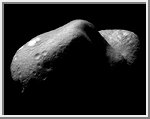 Over Eros' Horizon
Over Eros' Horizon
This incredible picture of Eros,
taken on February 14, 2000, shows the view looking from one
end of the asteroid across the gouge on its underside and
toward the opposite end. In this mosaic, constructed from
two images taken after the NEAR spacecraft was inserted
into orbit, features as small as 120 feet (35 meters)
across can be seen. House-sized boulders are present in
several places; one lies on the edge of the giant crater
separating the two ends of the asteroid. A bright patch is
visible on the asteroid in the top left-hand part of this
image, and shallow troughs can be see just below this
patch. The troughs run parallel to the asteroid's long
dimension.
(Courtesy of NASA/JHU-APL)
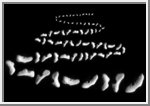 NEAR's road to Eros
NEAR's road to Eros
This montage shows a
selection of images of the asteroid 433 Eros that were
acquired from the NEAR spacecraft over three weeks from
January 22 through February 12, 2000, as the spacecraft's
distance from its target shrank from 18,000 to 1260 miles
(29,000 to 2025 km). As the spacecraft closed in on its
target, the resolution of the images increased from 1.7 to
0.12 miles (2.8 to 0.19 km) per pixel.
During the early stages of
NEAR's approach, Eros appeared as a small blob only a few
pixels across. The apparent size of Eros and the resolution
of the pictures increased continuously, at first only
slowly and later dramatically day by day until, on February
9, the level of detail visible exceeded that during NEAR's
first flyby of Eros on December 23, 1998. In the last
images shown here, details of Eros's surface have become
visible. Heavy cratering has pockmarked the irregular
asteroid's surface. One side is dominated by a
scallop-rimmed gouge, and the opposite side by a
conspicuous, raised-rimmed crater.
(Courtesy NASA/JHU-APL)
Copyright © 1997-2000 by Calvin J. Hamilton. All rights reserved. Privacy Statement.